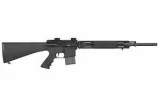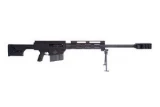About HK MR762A1 MR762FMA1
Like its 5.56 mm counterpart, the MR762A1 is a direct descendant of the HK416/417 series, only in a semi-automatic rifle configuration developed for civilian users. Using the HK-proprietary operating system, the MR762A1 is gas operated and uses a piston and a solid operating "pusher" rod in place of the common gas tube normally employed in AR15/M16/M4-style weapons. This method virtually eliminates malfunctions common to direct impingement gas systems since hot carbon fouling and waste gases do not enter the receiver area. The MR762A1 stays cleaner, reducing heat transfer to the bolt and bolt carrier, and drastically reducing wear and tear on other critical components. This rifle uses a barrel produced by Heckler & Koch s famous cold hammer forging process. The manufacturing process uses the highest quality steel, producing a barrel that ensures superior accuracy, even after firing thousands of rounds. It features many of the assemblies and accessories originally developed for the HK416/417 series including adjustable buttstocks, ergonomic pistol grips, mechanical sights, and the HK free-floating four-quadrant rail system/handguard. This MIL-STD-1913 "Picatinny" type rail system allows all current accessories, sights, lights, and aimers used on M4/M16-type weapons to be fitted to the MR series. Many ambidextrous operating controls are standard on the MR762A1, including a convertible charging handle and an ambidextrous selector lever. It uses 10- and 20-round translucent polym
HK MR762A1 MR762FMA1 For Sale
Specifications
| Brand | Heckler & Koch Inc |
|---|---|
| Category | Rifles |
| Action | Semi-Automatic |
| Caliber | .308 Winchester |
| Capacity | 10+1 |
| Finish | Black |
| Barrel Length | 16.5 " |
HK MR762A1 MR762FMA1 Comparisons
HK MR762A1 MR762FMA1 Variations
Similar Products
HK MR762A1 MR762FMA1 Questions and Answers
No Questions Yet.




















